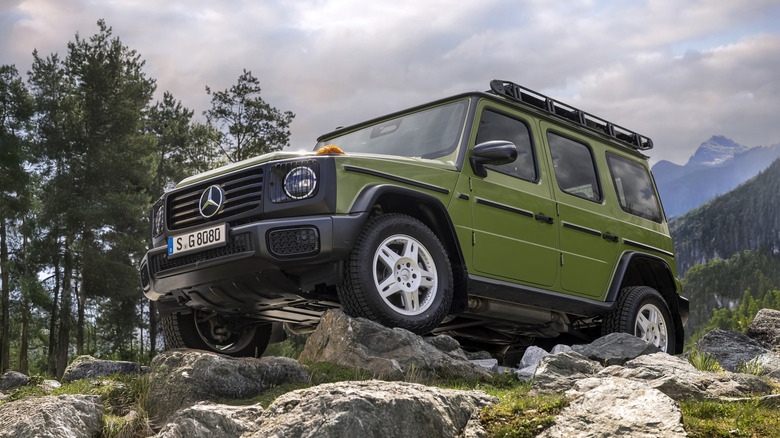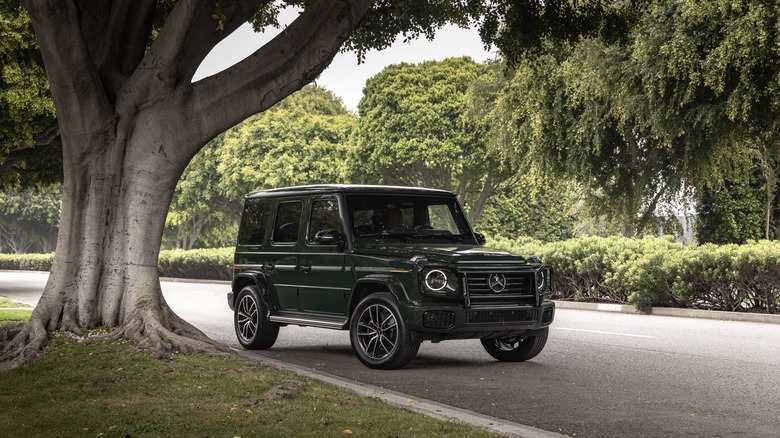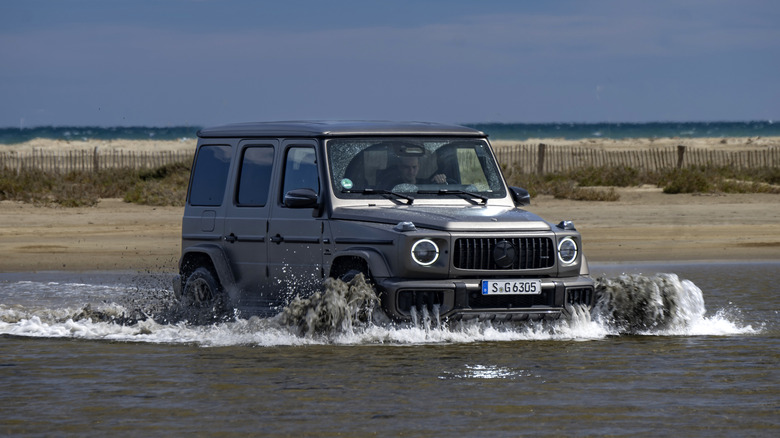
Mercedes-Benz is probably best-known for its luxury vehicles, but the company also has a long history building more utilitarian choices, such as HD trucks, commercial vans, taxis, and military-capable rides such as the cult-fave Unimog -- like the ones spending time in Park City's fleet. From that machine, which M-B began producing in the 1950s — after buying the Unimog's original manufacturer — came the idea for a somewhat less extreme street-legal offering that was still tough enough for customers
with a very particular set of skills.
The result was the Mercedes-Benz Geländewagen. Debuting in 1979, the SUV came with a name translated as "cross-country vehicle," which is often shortened to "G-Wagon" or "G-Wagen," and lives on today as the automaker's G-Class. Much has obviously changed since the original, with the latest generation G-Class even available as an EV. In fact, the new Popemobile is an electric Mercedes-Benz G-Wagen.
In addition, about 45 countries continue to use G-Wagons for military roles. Consider the G-Class Caracal that's specifically tailored for special forces: Although small enough to fit two in a transport helicopter, the Caracal can be outfitted for transporting troops, to serve as a medical/supply vehicle, and to carry anti-tank weapons. That's not an option for the G-Class variants at your local dealership, but the retail version is still plenty tough.
Read more: These Are The Cars You'd Buy If They Were $20,000 Cheaper
Can Today's G-Wagons Go Cross-Country?

The short answer: You bet. The 2025 Mercedes-Benz G-Class remains true to its roots with body-on-frame construction and a design and features tailored for tackling some of the world's toughest off-road conditions. Right off the bat, the current G-Wagon has 9.5 inches of ground clearance with the ability to ford water up to 27.6 inches deep. It can also make it up a 100% grade (on some surfaces) while showing off approach/departure angles of 30.6 and 29.9 degrees.
There's no shortage of trail-friendly hardware, either. Among the highlights are front, center, and rear locking differentials along with a long-travel suspension backed by a solid rear axle and a multi-speed transfer case with a dedicated low range. The AMG Offroad Pack Pro is also available to add hydraulic roll stabilization and adaptive damping.
Of course, this being a Mercedes-Benz, the G-Class can further showcase a wide range of smart technologies for when the pavement ends. The Transparent Hood -- not to be confused with the one in the new Land Rover Discovery -- can be especially useful. It leverages a 12.3-inch display and a camera system to show a view of what's under the front of the vehicle, as if you're looking ahead and through the hood.
2025 G-Class: Three Powertrains, One Mission

The 2025 G-Class is made up of the G 550, the G 580 with EQ Technology, and the AMG G 63, all offering not only incredible offroad prowess but also lavish luxury cues. Manufaktur Nappa leather, climate-controlled massaging seats, Burmester 3D audio, a cherry wood floor in the cargo bay, and carbon-fiber details are all in the mix here. The primary difference is what's under the hood: The G 550 pairs a 3.0-liter turbocharged I6 with a 9-speed automatic transmission for 443 horsepower and a 0-60 time of 5.3 seconds.
Additionally, the gas-powered G-Class models get mild-hybrid setups for a small electric assist. Very small, since the G 550 has EPA ratings of 17 mpg city/19 mpg highway/18 mpg combined. For an EV SUV, pick the G 580 with EQ Technology. It has four electric motors, one for each wheel, plus a 116-kWh battery pack, to make 579 total horsepower. This is routed through a shiftable two-speed automatic transmission with a low-range function. In terms of efficiency, the EPA rates the G 580 as having a 239-mile EV range -- on the road, of course.
The highest performer is the AMG G 63 with its hand-crafted twin-turbo V8 that pours out 577 horses through an AMG-tuned 9-speed autobox. Floor this beast, and it bolts to 60 in 4.2 seconds. On the other hand, it's quick to need refueling, too, as even with its own mild-hybrid system, it checks in with an EPA line of 14/16/15.
Want more like this? Join the Jalopnik newsletter to get the latest auto news sent straight to your inbox...
Read the original article on Jalopnik.











